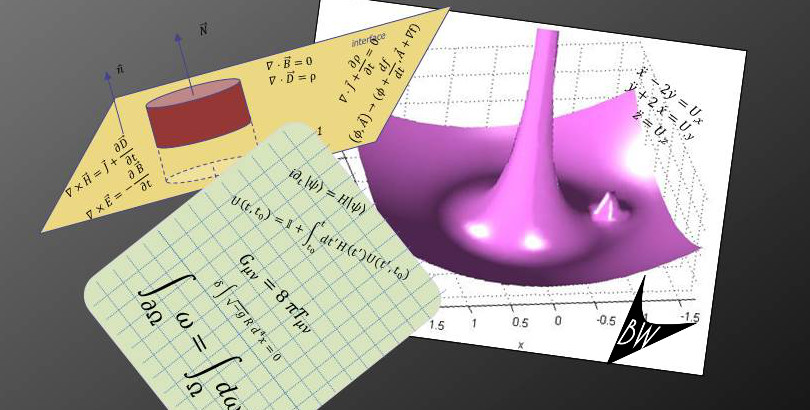A Curvilinear Mantra – Part 2
The last post introduced the curvilinear mantra for students working with field equations in such disciplines as fluid mechanics, general relativity, and electricity and magnetism. The textbook example (see, e.g. Acheson Appendix A, pp 352-3) is Euler’s equations for ideal fluids in two spatial dimensions.
In cartesian coordinates these equations read
\[ \rho \left( V_x \partial_x + V_y \partial_y + \partial_t \right) V_x = – \partial_x p + f_x \; \]
and
\[ \rho \left( V_x \partial_x + V_y \partial_y + \partial_t \right) V_y = -\partial_y p + f_y \; ,\]
whereas, in polar coordinates these equations read
\[ \rho \left( V_r \partial_r + \frac{V_\theta}{r} \partial_\theta + \partial_t \right) V_r – \rho \frac{{V_\theta}^2}{r} = -\partial_r p + f_r \; \]
and
\[ \rho \left( V_r \partial_r + \frac{V_\theta}{r} \partial_\theta + \partial_t \right) V_\theta + \rho \frac{V_r V_\theta}{r} = -\frac{1}{r} \partial_\theta p + f_\theta \; . \]
As discussed in the previous post, beginning students are often confused by two changes when transitioning from cartesian to polar coordinates. The first is the appearance of $1/r$ scale factors that decorate various terms such as $V_\theta/r \partial_\theta$. The second is the appearance of additional additive terms, such as $V_r V_\theta/r$.
The curvilinear mantra explains these changes as follows: the scale factors come from minding the units and the additive terms show up to account for how the basis unit vectors change from place to place.
The first half of the mantra was covered in the previous post. This post finishes the exploration by demonstrating how the additive terms arise due to the spatial variations of the basis vectors.
The first step involves writing the position vector in terms of the polar coordinates and the cartesian unit basis vectors
\[ {\vec r} = r \cos \theta {\hat x} + r \sin \theta {\hat y} \; .\]
The polar unit basis vectors are defined by taking the derivatives of the position vector with respect to the polar coordinates and then unitizing. The radial basis vector (not unitized) is
\[ {\vec e}_r \equiv \frac{\partial {\vec r}}{\partial r} = \cos \theta {\hat x} + \sin \theta {\hat y} \; .\]
Conveniently, this vector has a unit length and we can immediately write the radial unit basis vector as
\[ {\hat r} = \cos \theta {\hat x} + \sin \theta {\hat y} \; . \]
Following the same procedure, the polar angle basis vector (not unitized) is
\[ {\vec e}_\theta \equiv \frac{\partial {\vec r}}{\partial \theta} = -r \sin \theta {\hat x} + r \cos \theta {\hat y} \; . \]
This vector has length $r$ and so the polar angle unit base vector is
\[ {\hat \theta} = -\sin \theta {\hat x} + \cos \theta {\hat y} \; .\]
Both vectors are independent of $r$ but do depend on $\theta$ and their variations are
\[ \partial_\theta {\hat r} = {\hat \theta} \; \]
and
\[ \partial_\theta {\hat \theta} = – {\hat r} \; . \]
At this point we have all the ingredients we need. From the first part of the curvilinear mantra we have the velocity in polar coordinates is
\[ {\vec V} = V_r {\hat r} + \frac{V_\theta}{r} {\hat \theta} \; \]
and the material (or total) time derivative is
\[ \frac{D}{Dt} = V_r \partial_r + \frac{V_\theta}{r} \partial_\theta + \partial_t \; , \]
where the scale factors on the polar angle terms are due to minding units.
Applying the material time derivative to the velocity gives
\[ \frac{D {\vec V}}{Dt} = \left( V_r \partial_r + \frac{V_\theta}{r} \partial_\theta + \partial_t \right) \left( V_r {\hat r} + \frac{V_\theta}{r} {\hat \theta} \right) \; . \]
Expanding this expression term-by-term yields
\[ V_r \partial_r \left( V_r {\hat r} \right) + \frac{V_\theta}{r} \partial_\theta \left( V_\theta {\hat \theta} \right) + \frac{V_\theta}{r} \partial_\theta \left( V_r {\hat r} \right) + \left(\partial_t V_r \right) {\hat r} + \left( \partial_t V_\theta \right) {\hat \theta} \; . \]
Expanding the derivatives, taking care to evaluate the spatial derivatives of the unit basis vectors, yields
\[ V_r \partial_r V_r {\hat r} + \frac{V_\theta}{r} \left( \partial_\theta V_\theta \right) {\hat \theta} – \frac{{V_\theta}^2}{r} {\hat r} + \left( \frac{V_\theta}{r} \partial_\theta V_r \right) {\hat r} + \\ \frac{V_\theta V_r}{r} {\hat \theta} + \left(\partial_t V_r \right) {\hat r} + \left( \partial_t V_\theta \right) {\hat \theta} \; . \]
Collecting terms gives the radial term as
\[ V_r \partial_r V_r + \frac{V_\theta}{r} \partial_\theta V_r – \frac{{V_\theta}^2}{r} + \partial_t V_r \; \]
and the polar angle term as
\[ \frac{V_\theta}{r} \partial_\theta V_\theta + \frac{V_\theta}{r} \partial_\theta V_\theta + \frac{V_\theta V_r}{r} + \partial_t V_\theta \; .\]
Factoring the terms yields
\[ \left( V_r \partial_r + \frac{V_\theta}{r} \partial_\theta + \partial_t \right) V_r – \frac{{V_\theta}^2}{r} \; \]
and
\[ \left( V_r \partial_r + \frac{V_\theta}{r} \partial_\theta + \partial_t \right) V_\theta + \frac{V_\theta V_r}{r} \; .\]
Happily, these expressions match term-for-term the textbook (up to multiplication by $\rho$). This shows the accuracy and power of the curvilinear mantra. Hopefully it will catch on in classrooms.
